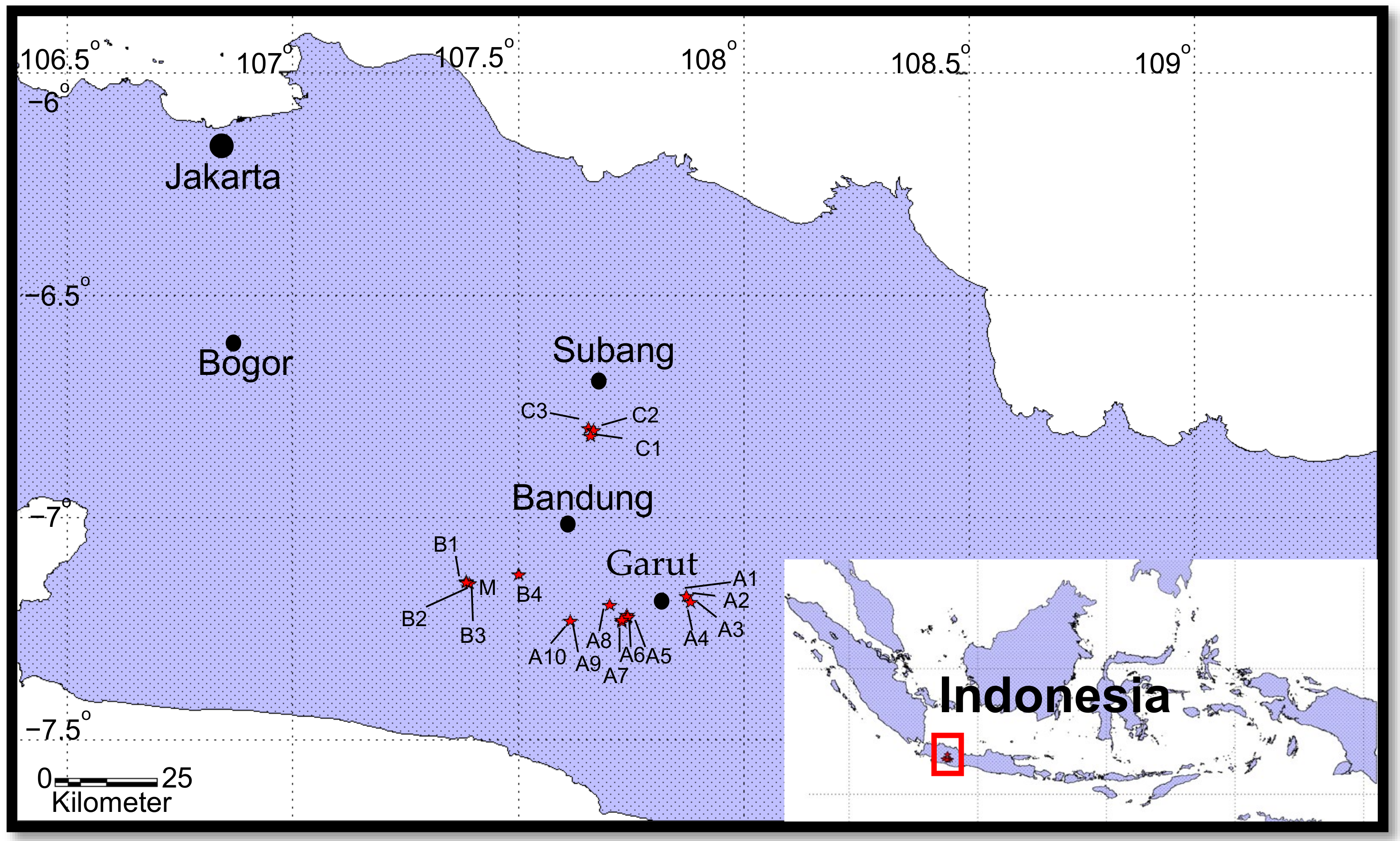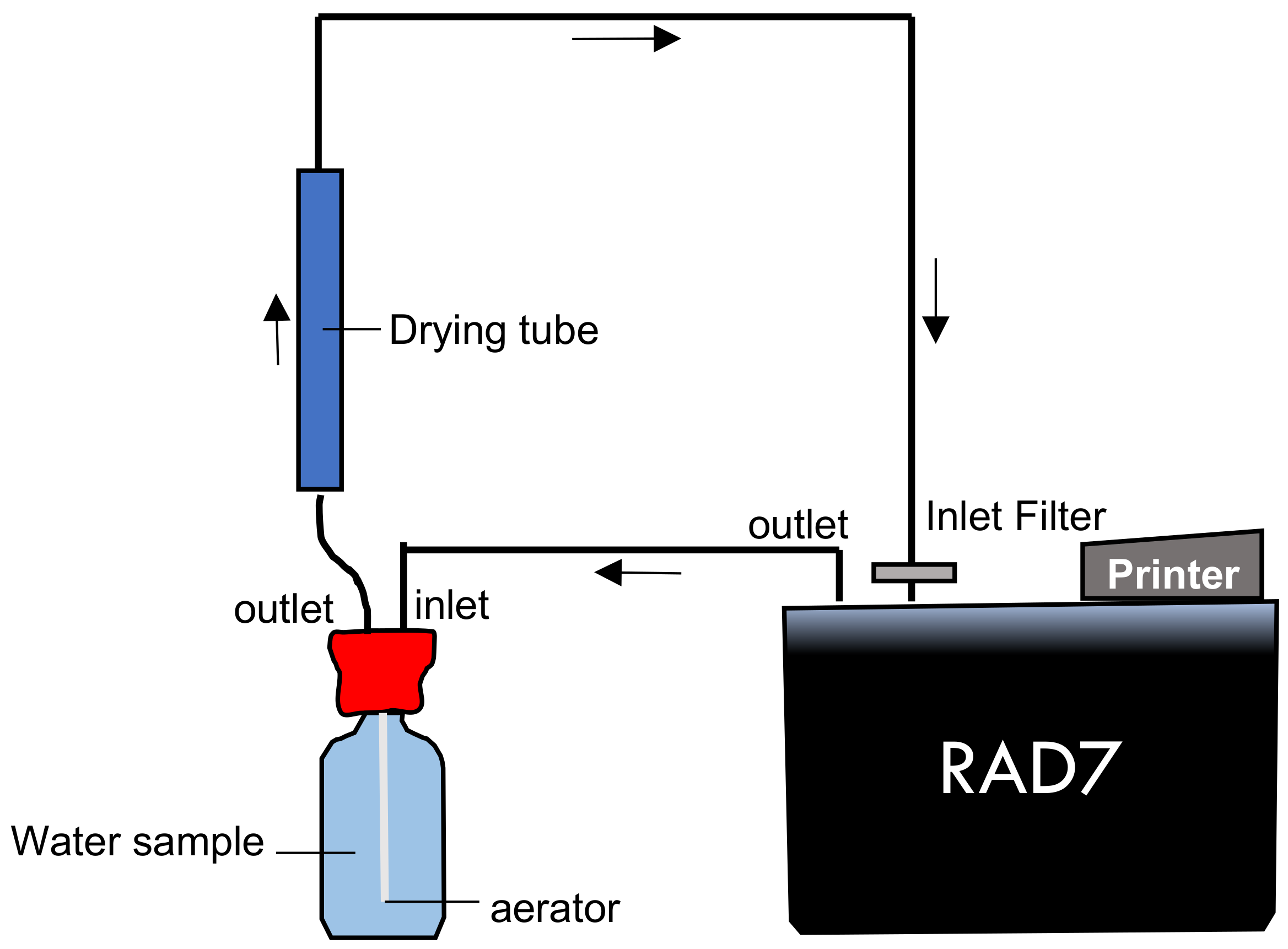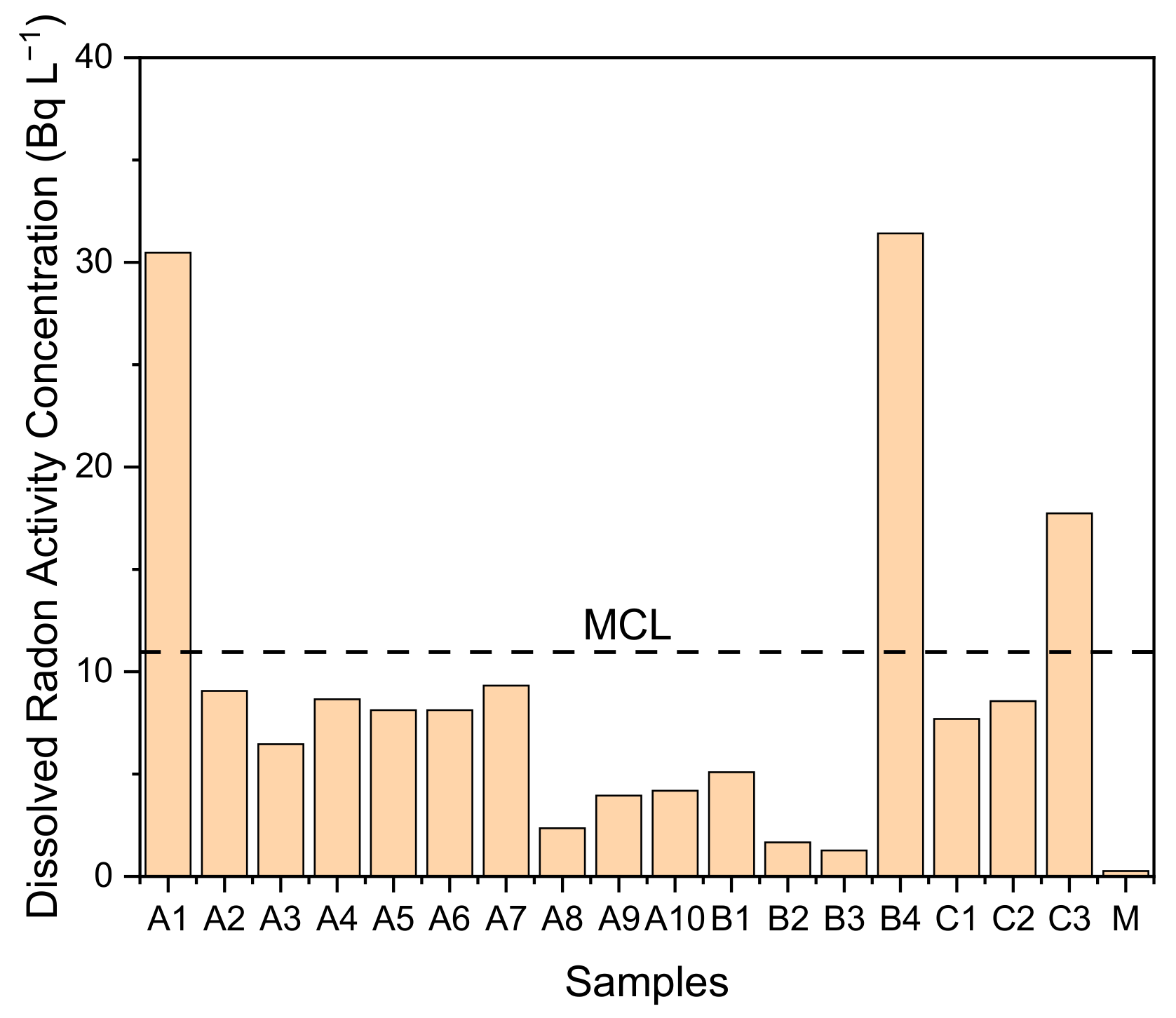Radon Activity Concentrations in Natural Hot Spring Water: Dose Assessment and Health Perspective
Abstract
1. Introduction
2. Materials and Methods
2.1. Study Area
2.2. Radon Measurement in Water Samples
2.3. Radon Measurement in the Air
2.4. Estimation of Annual Effective Dose
3. Results and Discussion
4. Conclusions
Author Contributions
Funding
Institutional Review Board Statement
Informed Consent Statement
Conflicts of Interest
References
- United Nations Scientific Committee on the Effects of Atomic Radiation. UNSCEAR 2008 Report, Sources and Effects of Ionising Radiation. Volume I: Annex B Exposures of the Public and Workers from Various Sources of Radiation; UNSCEAR: New York, NY, USA, 2010. [Google Scholar]
- World Health Organization. WHO Handbook on Indoor Radon: A Public Health Perspective; WHO: Geneva, Switzerland, 2009. [Google Scholar]
- International Commission on Radiological Protection. Annals of the ICRP: Occupational Intakes of Radionuclides: Part 3; ICRP: New York, NY, USA, 2017. [Google Scholar]
- United State of America Environmental Protection Agency. USEPA (1991) National Primary Drinking Water Regulations: Radionuclides (Proposed Rule) Federal Register; U.S. E.P.A.: New York, NY, USA, 1991.
- Gruber, V.; Maringer, F.J.; Landstetter, C. Radon and other natural radionuclides in drinking water in Austria: Measurement and assessment. Appl. Radiat. Isot. 2009, 67, 913–917. [Google Scholar] [CrossRef] [PubMed]
- Sola, P.; Srisuksawad, K.; Loaharojanaphand, S. Radon activity concentration in air, hot spring water, and bottled mineral water in one hot spring area in Thailand. J. Radioanal. Nucl. Chem. 2013, 297, 183–187. [Google Scholar] [CrossRef]
- Nugraha, E.D.; Hosoda, M.; Kusdiana, I.; Winarni, D.; Prihantoro, A.; Suzuki, T.; Tamakuma, Y.; Akata, N.; Tokonami, S. Dose assessment of radium-226 in drinking water from Mamuju, a high background radiation area of Indonesia. Radiat. Environ. Med. 2020, 9, 79–83. [Google Scholar]
- Patricia, J.E. An assessment of Role of Natural Hot and Mineral Springs in Health, Wellness and Recreational Tourism. Ph.D. Thesis, James Cook University, Douglas, Australia, November 2011. [Google Scholar]
- Fitriyani, P.; Waluya, B. The influence of competitive advantage in the tourist area of the hot spring water park, Sabda alam hotels and resorts Cipanas, Garut Regency in increasing visiting decisions (Pengaruh keunggulan bersaing di kawasan wisata air panas taman air sabda alam hotel dan resort cipanas kabupaten garut dalam meningkatkan keputusan berkunjung). Tour. Hosp. Essent. J. 2013, 1, 483. [Google Scholar]
- Ananda, R.P.; Ahman, E.; Riwanudin, O. The effect of physical evidence of Ciwalini hot springs on the decision to visit tourists (Pengaruh physical evidence pemandian air panas ciwalini terhadap keputusan berkunjung wisatawan). Tour. Hosp. Essent. J. 2013, 1, 461. [Google Scholar]
- Arif, M. Limit Proccess Application of Acceptable Change in Sari Ater Hot Spring Resort. Ph.D. Thesis, Tourism University, Hong Kong, January 2016. [Google Scholar]
- Nugraha, W.; Kusdiana, E.D.; Iskandar, D. Radon activity concentrations in dwellings in East Kalimantan. In Proceedings of the National Seminar of Sains and Technology 2017, Bandung, Indonesia, 14 November 2017. [Google Scholar]
- Nugraha, E.D.; Wahyudi, K.; Iskandar, D. Radon activity concentrations in dwelling of South Kalimantan, Indonesia. Radiat. Prot. Dosim. 2019, 184, 463–465. [Google Scholar] [CrossRef]
- Saputra, M.A.; Nugraha, E.D.; Purwanti, T.; Arifianto, R.; Laksmana, R.I.; Hutabarat, R.P.; Hosoda, M.; Tokonami, S. Exposures from radon, thoron, and thoron progeny in high background radiation area in Takandeang, Mamuju, Indonesia. Nukleonika 2020, 65, 89–94. [Google Scholar] [CrossRef]
- Hosoda, M.; Nugraha, E.D.; Akata, N.; Yamada, R.; Tamakuma, Y.; Sasaki, M.; Kelleher, K.; Yoshinaga, S.; Suzuki, T.; Rattanapongs, C.P.; et al. A unique high natural background radiation area—Dose assessment and perspectives. Sci. Total Environ. 2021, 750, 142346. [Google Scholar] [CrossRef]
- Iskandar, I.; Dermawan, F.A.; Sianipar, J.; Suryantini, Y.; Notosiswoyo, S. Characteristic and Mixing Mechanisms of Thermal Fluid at the Tampomas Volcano, West Java, Using Hydrogeochemistry, Stable Isotope and 222Rn Analyses. Geosciences 2018, 8, 103. [Google Scholar] [CrossRef]
- Durridge. Manual Book of RAD7; Durridge Company Inc.: Billerica, MA, USA, 2018. [Google Scholar]
- United Nations Scientific Committee on the Effects of Atomic Radiation. UNSCEAR 2000 Report, Sources and Effects of Ionising Radiation. Volume I: Annex B Exposures from Natural Radiation Sources; UNSCEAR: New York, NY, USA, 2000. [Google Scholar]
- Hopke, P.K.; Borak, T.B.; Doull, J.; Cleaver, J.E.; Eckerman, K.F.; Gundersen, L.C.S.; Harley, N.H.; Hess, C.T.; Kinner, N.E.; Kopecky, K.J.; et al. Health risks due radon in drinking water. J. Environ Sci. Technol. 2000, 34, 921–926. [Google Scholar] [CrossRef]
- Tokonami, S. Some thought on new dose conversion factors for radon progeny inhalation. Jpn J. Health Phys. 2018, 53, 282–293. [Google Scholar] [CrossRef]
- Hosoda, M.; Fukui, Y.; Pornnumpa, C.; Sorimachi, S.; Ishikawa, T.; Yachi, M.; Nara, A.; Yokota, H.; Tokonami, S. Absorbed dose rate in air at the Bunkyo-cho Campus of Hirosaki University. Radiat. Environ. Med. 2014, 3, 59–62. [Google Scholar]
- Ministry of Health of Indonesia. Drinking Water Quality Reference Level; Ministry of Health of Indonesia: Jakarta, Indonesia, 2002.
- World Health Organization. WHO Guidelines for Drinking Water Quality, Vol. 1. Recommendations; WHO: Geneva, Switzerland, 2017. [Google Scholar]
- Kobal, I.; Krista, J.; Ancik, M.; Jerencic, S.; Skofljanec, M. Radioactivity of thermal and mineral springs in Slovenia. Health Phys. 1979, 37, 239–242. [Google Scholar] [PubMed]
- Nazaroff, W.; Nero, A. Radon and Its Decay Products in Air; John Wiley & Sons: New York, NY, USA, 1988. [Google Scholar]
- Soto, J.; Fernández, P.; Quindos, L.; Gomezarozamena, J. Radioactivity in Spanish spas. Sci. Total Environ. 1995, 162, 187–192. [Google Scholar] [CrossRef]
- Sabol, J.; Weng, P.-S.; Mao, C.-H. Monitoring of 222Rn in Taiwanese Hot Spring SPA Waters Using a Modified Electret Ion Chamber Method. Health Phys. 1995, 68, 100–104. [Google Scholar] [CrossRef]
- Szerbin, P. Natural radioactivity of certain spas and caves in Hungary. Environ. Int. 1996, 22, 389–398. [Google Scholar] [CrossRef]
- Przylibski, T. 222Rn concentration changes in medicinal groundwaters of Lądek Zdrój (Sudety Mountains, SW Poland). J. Environ. Radioact. 2000, 48, 327–347. [Google Scholar] [CrossRef]
- Horvath, A.; Bohus, L.O.; Urbani, F.; Marx, G.; Piroth, A.; Greaves, E.D. Radon activity concentration in hot spring waters in northern Venezuela. J. Environ. Radioact. 2000, 47, 127–133. [Google Scholar] [CrossRef]
- Trautmannsheimer, M.; Schindlmeier, W.; Boerner, K. Radon activity concentration measurements and personnel exposure levels in Bavarian water supply facilities. Health Phys. 2003, 84, 100–110. [Google Scholar] [CrossRef]
- Radolić, V.; Vuković, B.; Smit, G.; Stanic, D.; Planinić, J. Radon in the spas of Croatia. J. Environ. Radioact. 2005, 83, 191–198. [Google Scholar] [CrossRef]
- Jalili-Majareshin, A.; Behtash, A.; Rezaei-Ochbelagh, D. Radon activity concentration in hot springs of the touristic city of Sarein and methods to reduce radon in water. Radiat. Phys. Chem. 2012, 81, 749–757. [Google Scholar] [CrossRef]
- Utami, P. Characteristics of the Kamojang geothermal reservoir (West Java) as revealed by its hydrothermal alteration mineralogy. In Proceedings of the World Geothermal Congress 2000, Sendai, Japan, 28 May–10 June 2000. [Google Scholar]
- Sunarwan, B. Physical characterization of groundwater and identification of springs in the volcanic sediment aquifer (case study: Tangkuban perahu volcanic sediment in the Bandung basin) (karakterisasi phisik air tanah dan identifikasi pemunculan mata air pada akuifer endapan gunung api (studi kasus: Endapan gunungapi Tangkuban perahu di cekungan Bandung). Technol. J. Sci. Mag. Unpak. 2014, 15, 16–26. [Google Scholar]
- Hidayat, M.R.; Mardiana, U.; Suganda, B.R.; Hadian, M.S.D. Geometry activities of Bandung area and surroundings, West Java Province (geometri akifer daerah Bandung dan sekitarnya, Provinsi Jawa Barat). Padjajaran Univ. Geom. Sci. J. 2017, 1, 86–97. [Google Scholar]
- Song, G.; Zhang, B.; Wang, X.; Gong, J.; Chan, D.; Bernett, J.; Lee, S.C. Indoor radon levels in selected hot spring hotels in Guangdong, China. Sci. Total Environ. 2005, 339, 63–70. [Google Scholar] [CrossRef]



| Samples | Area | Longitude | Latitude | Elevation | Temperature | Electroconductivity at 25 °C | pH |
|---|---|---|---|---|---|---|---|
| (E) | (S) | (m) | (°C) | (mS cm−1) | |||
| A1 | Cipanas | 107.8716 | −7.17643 | 1678 | 38 | 1.511 | 6 |
| A2 | Cipanas | 107.8816 | −7.18884 | 1675 | 38 | 1.459 | 6 |
| A3 | Cipanas | 107.7016 | −7.19645 | 1668 | 39 | 1.485 | 6 |
| A4 | Cipanas | 107.5016 | −7.19646 | 1671 | 39 | 1.458 | 6 |
| A5 | Darajat | 107.7415 | −7.21833 | 1672 | 37 | 1.442 | 6 |
| A6 | Darajat | 107.7414 | −7.21914 | 1670 | 38 | 1.538 | 6 |
| A7 | Darajat | 107.7416 | −7.22191 | 1672 | 37 | 1.586 | 6 |
| A8 | Darajat | 107.7287 | −7.22935 | 1973 | 42 | 1.682 | 5 |
| A9 | Darajat | 107.7287 | −7.22906 | 1976 | 42 | 1.628 | 5 |
| A10 | Darajat | 107.7287 | −7.22851 | 1985 | 42 | 1.677 | 5 |
| B1 | Ciwidey | 107.3843 | −7.14416 | 1779 | 37 | 1.425 | 6 |
| B2 | Ciwidey | 107.3901 | −7.14710 | 1781 | 39 | 1.590 | 6 |
| B3 | Ciwidey | 107.3853 | −7.14429 | 1724 | 36 | 1.385 | 6 |
| B4 | Pangalengan | 107.6148 | −7.23211 | 1450 | 39 | 1.925 | 5 |
| C1 | Ciater | 107.6544 | −6.80861 | 873 | 36 | 1.401 | 6 |
| C2 | Ciater | 107.6544 | −6.80861 | 885 | 38 | 1.415 | 6 |
| C3 | Ciater | 107.6544 | −6.80862 | 897 | 39 | 1.598 | 5 |
| M | Bottled water | - | - | - | 25 | 0.164 | 7 |
| min | 36 | 0.164 | 5 | ||||
| max | 42 | 1.925 | 7 | ||||
| average | 39 | 1.541 | 6 | ||||
| Samples | Dissolved Radon in Water | Radon in Air | Ambient Dose Equivalent Rate | Radon Transfer Coefficient from Water to Air | Contributed Dissolved Radon in Water to Radon in Air | Annual Effective Dose due to Ingestion (mSv) | Annual Effective Dose due to External Exposure (mSv) | Total Annual Effective Dose (mSv) | |||
|---|---|---|---|---|---|---|---|---|---|---|---|
| Bq L−1 | Bq m−3 | nSv h−1 | Bq m−3 | Worker | Public | Worker | Public | Bq L−1 | Bq m−3 | ||
| A1 | 31 ± 3.4 | 48 ± 7 | 43 ± 2 | 5.9 × 10−4 | 3.1 | 0.65 | 0.13 | 0.04 | 0.01 | 0.69 | 0.13 |
| A2 | 9 ± 1.0 | 49 ± 7 | 41 ± 2 | 2.1 × 10−3 | 0.9 | 0.67 | 0.13 | 0.04 | 0.01 | 0.70 | 0.14 |
| A3 | 7 ± 0.7 | 42 ± 6 | 43 ± 2 | 1.8 × 10−3 | 0.7 | 0.57 | 0.11 | 0.04 | 0.01 | 0.61 | 0.12 |
| A4 | 9 ± 1.0 | 38 ± 6 | 41 ± 2 | 9.3 × 10−4 | 0.9 | 0.52 | 0.10 | 0.04 | 0.01 | 0.55 | 0.11 |
| A5 | 8 ± 0.9 | 39 ± 6 | 38 ± 2 | 1.1 × 10−3 | 0.8 | 0.53 | 0.10 | 0.03 | 0.01 | 0.57 | 0.11 |
| A6 | 8 ± 0.9 | 39 ± 6 | 37 ± 2 | 1.1 × 10−3 | 0.8 | 0.53 | 0.10 | 0.03 | 0.01 | 0.56 | 0.11 |
| A7 | 9 ± 1.0 | 40 ± 6 | 36 ± 2 | 1.1 × 10−3 | 0.9 | 0.54 | 0.10 | 0.03 | 0.01 | 0.58 | 0.11 |
| A8 | 2 ± 0.3 | 38 ± 6 | 40 ± 2 | 3.4 × 10−3 | 0.3 | 0.52 | 0.10 | 0.04 | 0.01 | 0.55 | 0.11 |
| A9 | 4 ± 0.4 | 38 ± 6 | 41 ± 2 | 2.0 × 10−3 | 0.4 | 0.52 | 0.10 | 0.04 | 0.01 | 0.55 | 0.11 |
| A10 | 4 ± 0.5 | 38 ± 6 | 40 ± 2 | 1.9 × 10−3 | 0.4 | 0.52 | 0.10 | 0.04 | 0.01 | 0.55 | 0.11 |
| B1 | 5 ± 0.6 | 38 ± 6 | 36 ± 2 | 2.0 × 10−3 | 0.5 | 0.52 | 0.10 | 0.03 | 0.01 | 0.55 | 0.11 |
| B2 | 2 ± 0.2 | 37 ± 6 | 38 ± 2 | 5.4 × 10−3 | 0.2 | 0.50 | 0.10 | 0.03 | 0.01 | 0.54 | 0.10 |
| B3 | 1 ± 0.1 | 35 ± 6 | 35 ± 2 | 5.5 × 10−3 | 0.1 | 0.48 | 0.09 | 0.03 | 0.01 | 0.51 | 0.10 |
| B4 | 31 ± 3.5 | 42 ± 7 | 44 ± 2 | 3.2 × 10−4 | 3.1 | 0.57 | 0.11 | 0.04 | 0.01 | 0.61 | 0.12 |
| C1 | 8 ± 0.9 | 48 ± 7 | 38 ± 2 | 1.7 × 10−3 | 0.8 | 0.65 | 0.13 | 0.03 | 0.01 | 0.69 | 0.13 |
| C2 | 8 ± 0.9 | 49 ± 8 | 37 ± 2 | 1.6 × 10−3 | 0.9 | 0.67 | 0.13 | 0.03 | 0.01 | 0.70 | 0.13 |
| C3 | 18 ± 2.0 | 50 ± 8 | 38 ± 2 | 2.0 × 10−3 | 1.8 | 0.68 | 0.13 | 0.03 | 0.01 | 0.71 | 0.14 |
| M | 0.3 ± 0.1 | - | - | - | 0.1 | - | |||||
| Average | 9 ± 1.0 | 42 ± 6 | 39 ± 2 | 2.0 × 10−3 | 0.9 | 0.53 | 0.11 | 0.04 | 0.01 | 0.60 | 0.12 |
| min | 1 ± 0.1 | 35 ± 5 | 35 ± 2 | 3.2 × 10−4 | 0.1 | 0.48 | 0.09 | 0.03 | 0.01 | 0.51 | 0.10 |
| max | 31 ± 3.5 | 50 ± 8 | 44 ± 2 | 5.5 × 10−3 | 3.1 | 0.68 | 0.13 | 0.04 | 0.01 | 0.71 | 0.14 |
Publisher’s Note: MDPI stays neutral with regard to jurisdictional claims in published maps and institutional affiliations. |
© 2021 by the authors. Licensee MDPI, Basel, Switzerland. This article is an open access article distributed under the terms and conditions of the Creative Commons Attribution (CC BY) license (http://creativecommons.org/licenses/by/4.0/).
Share and Cite
Nugraha, E.D.; Hosoda, M.; Mellawati, J.; Untara, U.; Rosianna, I.; Tamakuma, Y.; Modibo, O.B.; Kranrod, C.; Kusdiana, K.; Tokonami, S. Radon Activity Concentrations in Natural Hot Spring Water: Dose Assessment and Health Perspective. Int. J. Environ. Res. Public Health 2021, 18, 920. https://doi.org/10.3390/ijerph18030920
Nugraha ED, Hosoda M, Mellawati J, Untara U, Rosianna I, Tamakuma Y, Modibo OB, Kranrod C, Kusdiana K, Tokonami S. Radon Activity Concentrations in Natural Hot Spring Water: Dose Assessment and Health Perspective. International Journal of Environmental Research and Public Health. 2021; 18(3):920. https://doi.org/10.3390/ijerph18030920
Chicago/Turabian StyleNugraha, Eka Djatnika, Masahiro Hosoda, June Mellawati, Untara Untara, Ilsa Rosianna, Yuki Tamakuma, Oumar Bobbo Modibo, Chutima Kranrod, Kusdiana Kusdiana, and Shinji Tokonami. 2021. "Radon Activity Concentrations in Natural Hot Spring Water: Dose Assessment and Health Perspective" International Journal of Environmental Research and Public Health 18, no. 3: 920. https://doi.org/10.3390/ijerph18030920
APA StyleNugraha, E. D., Hosoda, M., Mellawati, J., Untara, U., Rosianna, I., Tamakuma, Y., Modibo, O. B., Kranrod, C., Kusdiana, K., & Tokonami, S. (2021). Radon Activity Concentrations in Natural Hot Spring Water: Dose Assessment and Health Perspective. International Journal of Environmental Research and Public Health, 18(3), 920. https://doi.org/10.3390/ijerph18030920










